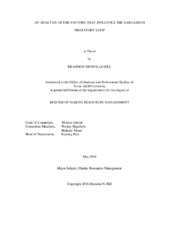| dc.contributor.advisor | Linton, Thomas | |
| dc.creator | Hill, Brandon Nicholas | |
| dc.date.accessioned | 2016-07-08T15:12:54Z | |
| dc.date.available | 2016-07-08T15:12:54Z | |
| dc.date.created | 2016-05 | |
| dc.date.issued | 2016-05-02 | |
| dc.date.submitted | May 2016 | |
| dc.identifier.uri | https://hdl.handle.net/1969.1/156969 | |
| dc.description.abstract | Certain variables suspected to influence the behavior of the Sargassum Migratory Loop System (SMLS) were examined using Robert Webster’s Development and Implementation of Sargassum Early Advisory System (SEAS). This analysis of the SMLS during the 2014 and 2015 Sargassum seasons was conducted as a case study to assign quantifiable weights to the behavioral characteristics of the SMLS. In 2014, Galveston, Texas experienced the largest landing of Sargassum in recorded history; in stark contrast it received practically no landings in 2015. The nations in the Caribbean Sea experienced an exceptionally large influx of Sargassum during the 2015 season. Based on the observations, it was theorized that among the causative factors for Texas were twenty-six cold fronts that occurred on the Upper Texas Coast in 2014, which held the Sargassum offshore in the nutrient-rich waters of the Gulf of Mexico. This period of suspension afforded the biomass an extended period of growth before landing. Similarly, in 2015 sustained southward fluctuations of the North Atlantic high pressure system forced Sargassum into contact with the nutrient-rich waters of the Orinoco and Amazon flood waters, thus producing enhanced growth of the Sargassum and its containment in the Caribbean Sea. Both of these instances involved specific atmospheric drivers influencing the flow of the Sargassum as it made its way through the SMLS. The areas the Sargassum was suspended in were high in nutrients due to the flushing of runoff from nearby shores. The annual flooding of the Amazon and Orinoco create a plume of neritic water that has been shown to cause increased growth as the Sargassum pass through that portion of the SMLS. The Gulf of Mexico, particularly the area known as the Bay of Campeche is so nutrient-rich that it has been thought to be the source of Sargassum.
For this case study the relevant factors include a combination of atmospheric forces known as teleconnection patterns, oceanic currents, and nutrient availability. A greater understanding of the relationship between these variables in the SMLS is a natural and necessary step. The extreme differences in the Sargassum landings between the 2014 and 2015 Sargassum seasons point to which variables drive the Sargassum’s movement to the greatest extent. Analyzing the relationship has increased forecasting accuracy and helps explain why particular seasons are seemingly incongruent with the current understanding of the causes. | en |
| dc.format.mimetype | application/pdf | |
| dc.language.iso | en | |
| dc.subject | Sargassum | en |
| dc.subject | SEAS | en |
| dc.subject | Pelagic | en |
| dc.subject | forecasting | en |
| dc.title | An Analysis of the Factors that Influence the Sargassum Migratory Loop | en |
| dc.type | Thesis | en |
| thesis.degree.department | Marine Sciences | en |
| thesis.degree.discipline | Marine Resources Management | en |
| thesis.degree.grantor | Texas A & M University | en |
| thesis.degree.name | Master of Marine Resources Management | en |
| thesis.degree.level | Masters | en |
| dc.contributor.committeeMember | Highfield, Wes | |
| dc.contributor.committeeMember | Moser, Melanie | |
| dc.type.material | text | en |
| dc.date.updated | 2016-07-08T15:12:54Z | |
| local.etdauthor.orcid | 0000-0001-8534-4897 | |


